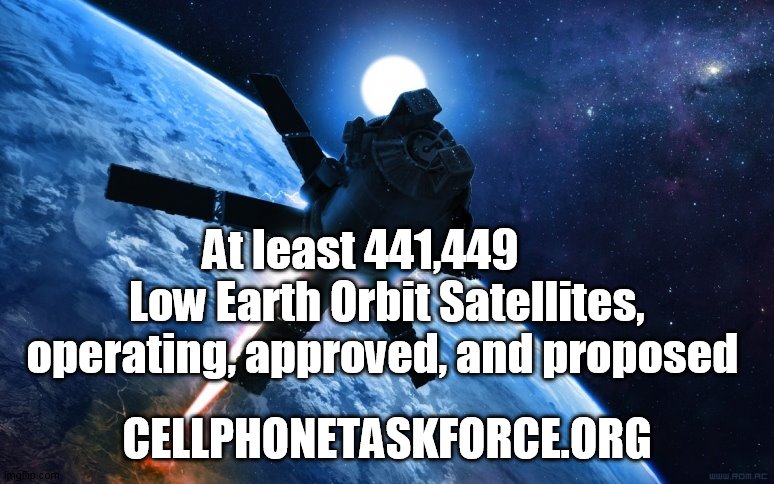 By B.N. Frank
By B.N. Frank
It’s hard to keep track of all the issues that have been reported about SpaceX’s Starlink broadband satellites. In fact, earlier this year the Federal Aviation Administration (FAA) proposed that SpaceX be fined for not properly reporting launch data of its Starlink satellites some of which have burned and fallen to the ground! Last year it was also reported that speed from Starlink satellites was slowing down everywhere!
Broadband connections can be achieved via safer and more secure methods than thousands more satellites being launched which are contributing to already dangerous levels of space junk. Scientists have also been warning about satellites’ impact on astronomical research for years and now again.
From Environmental Health Trust:
Rhodes University : New radio astronomical observations confirm unintended electromagnetic radiation emanating from satellites
Excerpt from Rhodes University
Scientists, including Rhodes University Visiting Professor Dr Gyula Józsa, use the LOFAR telescope to observe low-frequency radio waves from satellites in large constellations for the first time. “Unintended electromagnetic radiation” emanating from onboard electronics in Starlink satellites was detected, which could impact astronomical research.
For a study to be published in the Astronomy & Astrophysics journal, scientists from a number of leading research institutions [1] used the Low Frequency Array (LOFAR) telescope centred in the Netherlands to observe 68 Starlink satellites made by SpaceX. The authors conclude that they detected “unintended electromagnetic radiation” emanating from onboard electronics. This is different from communications transmissions, which had been the primary focus for radio astronomers so far. Further scientific evaluation including other satellite systems is underway, as this unintended radiation could impact astronomical research. The authors encourage satellite operators and regulators to consider this impact on radio astronomy in spacecraft development and regulatory processes alike.
Read more here.
This press release is from the International Astronomical Union’s Centre for the Protection of the Dark and Quiet Sky from Satellite Constellation Interference (IAU CPS) is a global organisation co-hosted by the US-based NSF’s NOIRLab and the SKA Observatory (SKAO), under the auspices of the IAU. The CPS facilitates global coordination of efforts by the astronomical community in concert with observatories, space agencies, industry, regulators and other sectors to help mitigate the negative consequences of satellite constellations on astronomy.
The news was also featured in Phys.org New radio observations confirm unintended electromagnetic radiation emanating from large satellite constellations and Interested Engineering Starlink satellite radiation still impacting radio astronomy
In 2022, a landmark new U.S. Government Accountability Office report documents the potential environmental impacts of satellites and ways to mitigate the effects.
“The environmental impacts of satellite systems must be evaluated before deployment,” stated Devra Davis PhD, MPH, President of the Environmental Health Trust.
“For decades, satellites have been used for GPS, communications, and remote sensing. The number of satellites has recently increased, as thousands more have been launched to provide internet access. But this increase may be disruptive. For example, it could lead to more space debris, which can damage existing satellites used for commerce or national security. We reviewed technologies and other tools to lessen potential effects. We also looked at mitigation challenges, like unclear rules and immature technology. To help address the challenges, we developed policy options, which may help policymakers achieve a variety of goals.”
“The unfettered rollout of satellites will have serious unintended consequences to human health and the environment. Satellites, 5G, and cell towers all exemplify the concept of a regulatory gap,” stated Theodora Scarato, Executive Director of the Environmental Health Trust. “GAO assessed technologies and approaches to evaluate and mitigate the following potential effects:
- Increase in orbital debris. Debris in space can damage or destroy satellites, affecting commercial services, scientific observation, and national security. Better characterizing debris, increasing adherence to operational guidelines, and removing debris are among the possible mitigations, but achieving these is challenging.
- Emissions into the upper atmosphere. Rocket launches and satellite reentries produce particles and gases that can affect atmospheric temperatures and deplete the ozone layer. Limiting the use of rocket engines that produce certain harmful emissions could mitigate the effects. However, the size and significance of these effects are poorly understood due to a lack of observational data, and it is not yet clear if mitigation is warranted.
- Disruption of astronomy. Satellites can reflect sunlight and transmit radio signals that obstruct observations of natural phenomena. Satellite operators and astronomers are beginning to explore ways of mitigating these effects with technologies to darken satellites, and with tools to help astronomers avoid or filter out light reflections or radio transmissions. However, the efficacy of these techniques remains in question, and astronomers need more data about the satellites to improve mitigations.
Activist Post reports regularly about broadband, space vehicles, and unsafe technologies. For more information, visit our archives.
Become a Patron!
Or support us at SubscribeStar
Donate cryptocurrency HERE
Subscribe to Activist Post for truth, peace, and freedom news. Follow us on SoMee, Telegram, HIVE, Flote, Minds, MeWe, Twitter, Gab, and What Really Happened.
Provide, Protect and Profit from what’s coming! Get a free issue of Counter Markets today.


Be the first to comment on "Scientists Report Electromagnetic Radiation from Broadband Satellites Could Impact Astronomical Research"